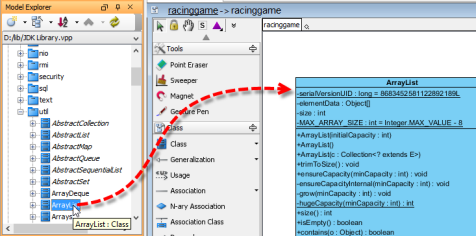Objectaid Uml Explorer Home How to install papyrus and generate java code in eclipse mars 2 uml getting started modeling in eclipse installing a maven project in eclipse version mars 2 4 5 objectaid uml explorer. Eclipse/Installation - Installing Eclipse is relatively easy, but does involve a few steps and software from at least two different. Demonstrate how to use Eclipse to generate UML diagram with objectaid software and how to generate Javadoc with Eclipse.
IntelliJ IDEA lets you generate a diagram on a package in your project. Such diagrams always reflect the structure of actual classes and methods in your application.
View diagram on a package
- The ObjectAid UML Explorer is different from other UML tools. It uses the UML notation to show a graphical representation of existing code that is as accurate and up-to-date as your text editor, while being very easy to use. Several unique features make this possible.
- The ObjectAid UML Explorer is a freemium and lightweight tool that helps to visualize and generate Class and sequence diagrams straight from your java code. It is available as a free eclipse plugin in eclipse marketplace.
- ObjectAid fills this gap, because you can maintain your class diagrams up to date. Not sure if this is still problem of recent versions, because my diagrams are short lived. The ObjectAid UML Explorer is optimized for the quick and easy creation of UML class and sequence diagrams from existing Java source code and libraries.
In the Project tool window, right-click a package for which you want to create a diagram and select Diagrams | Show DiagramCtrl+Alt+Shift+U ).
In the list that opens, select Java Class Diagram. IntelliJ IDEA generates a UML diagram for classes and their dependencies.
Bluestacks mac system requirements. You can view your VCS local changes as a diagram. Select VCS | Show Local Changes as UMLCtrl+Alt+Shift+D.
Analyze class diagram
You can press Ctrl+F12 on the element to view a list of diagram elements and navigate between them.
To see the list of methods, fields, and other code elements, select the appropriate icon on the diagram toolbar located on top of the diagram editor.
The lists are displayed based on the selected visibility level, which you can change. For example, to view protected methods, click on the diagram toolbar and select protected from the list. IntelliJ IDEA displays members with visibility not less than protected, such as public, package local, and protected ones. The protected methods are displayed with modifier icons next to them.
You can click the icon to see class dependencies. IntelliJ IDEA follows the UML conventions in showing relationships between the classes.
When you click through classes in the graph, IntelliJ IDEA greys out classes that do not reside in the same package. This might be helpful, when you generate a diagram on a package that contains inner packages.
To save the diagram as a file, right-click the diagram editor and from the context menu, select Save UML Diagram.
Objectaid Uml Eclipse
Manage class diagram
When working with diagrams, use the context menu in the diagram editor to perform different tasks. You can view members of the class, add new, delete the existing ones, see implementations, check parent classes, perform basic refactoring, add notes, and so on.

You can select the icon on the diagram toolbar to draw relationship links between elements in your graph. To delete the existing links, select the ones you don't need and press Delete. IntelliJ IDEA will update the source code accordingly.

Press Space.
In the search field that opens, start typing a name of the class you want to add. Then, select the desired class from the suggestion list.
If you want to add a class that is out of the project scope, select the Include non-project items checkbox.
In the diagram editor, select a node element you want to delete.
- Right-click the element and from the context menu, select DeleteDelete.
Alternatively, select Refactor | Safe DeleteAlt+Delete. In this case, IntelliJ IDEA checks for usages before applying the changes.

You can quickly search for usages by pressing Alt+F7 on a code element.

You can perform some forward engineering while in the diagram editor.
In the diagram editor, right-click anywhere and from the context menu, select New. Then select a code element you want to create.
Depending on your selection, IntelliJ IDEA opens the appropriate dialog where you specify the necessary information for creating the new element.
IntelliJ IDEA adds the item to your diagram as well as to your project tree.
You can view implementations and parent classes in your diagram. If IntelliJ IDEA finds more than one parent class or implementation, it displays a list of appropriate items. Select the one you need to see the connections between the parent and its children.
In the diagram editor, select an item for which you want to see implementations or parent classes.
Right-click the items and from the context menu, select the Show ImplementationsCtrl+Alt+B or Show ParentsCtrl+Alt+P respectively.
In the popup that opens, select items you need and press Enter. To extend your selection up or down while in the popup, press Shift + Up or Shift + Down respectively.

You can configure the diagram settings, so that you have certain options available to you by default when you create your diagram.
Objectaid Download
Press Ctrl+Alt+S to open IDE settings and select Tools | Diagrams.
In the right-hand pane, select the options that you want to see by default and click OK to apply your changes.



